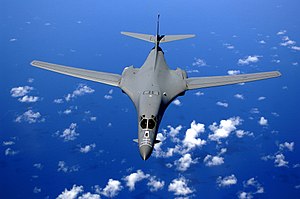B-1B Lancer
| B-1 Lancer | |
|---|---|
 |
|
| A B-1B flying over the Pacific Ocean. | |
| Role | Supersonic heavy strategic bomber |
| National origin | United States |
| Manufacturer |
North American Rockwell/Rockwell International Boeing |
| First flight | 23 December 1974 |
| Introduction | 1 October 1986 |
| Status | In service |
| Primary user | United States Air Force |
| Produced | 1973–74, 1983–88 |
| Number built | B-1A: 4 B-1B: 100 |
| Unit cost |
US$283.1 million in 1998 (B-1B)
|
| Rockwell B-1A Cutaway | |
|
|
The Rockwell B-1 Lancer is a four-engine supersonic variable-sweep wing, jet-powered heavy strategic bomber used by the United States Air Force (USAF). It was first envisioned in the 1960s as a supersonic bomber with Mach 2 speed, and sufficient range and payload to replace the Boeing B-52 Stratofortress. It was developed into the B-1B, primarily a low-level penetrator with long range and Mach 1.25 speed capability at high altitude. It is commonly called the "Bone" (originally from "B-One").
Designed by Rockwell International (now part of Boeing), development was delayed multiple times over its history due to changes in the perceived need for manned bombers. The initial B-1A version was developed in the early 1970s, but its production was canceled, and only four prototypes were built. The need for a new platform once again surfaced in the early 1980s, and the aircraft resurfaced as the B-1B version with the focus on low-level penetration bombing. However, by this point, development of stealth technology was promising an aircraft of dramatically improved capability. Production went ahead as the B version would be operational before the "Advanced Technology Bomber" (which became the B-2 Spirit), during a period when the B-52 would be increasingly vulnerable. The B-1B entered service in 1986 with the USAF Strategic Air Command (SAC) as a nuclear bomber.
In the early 1990s, following the Gulf War and concurrent with the disestablishment of SAC and its reassignment to the newly formed Air Combat Command (ACC), the B-1B was converted to conventional bombing use. It first served in combat during Operation Desert Fox in 1998 and again during the NATO action in Kosovo the following year. The B-1B has supported U.S. and NATO military forces in Afghanistan and Iraq. The B-1B is expected to continue to serve into the 2030s, with the Long Range Strike Bomber to start supplementing the B-1B in 2030.
...
Wikipedia
